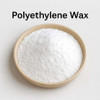Polyethylene Wax, also known as PE Wax, is a versatile polymer wax used in many industries. It is valued for its hardness, high melting point, smooth texture, and chemical stability. PE Wax is widely used in plastics, coatings, inks, adhesives, and candle making as a functional additive.
Key Properties of Polyethylene Wax:
- High hardness and toughness
- Excellent thermal stability
- Good chemical resistance
- Low viscosity at melt stage
- Non-toxic and safe to handle
- Provides smooth, glossy surface finish
Applications of Polyethylene Wax:
- Color concentrate: works as a dispersion agent in pigments
- Lubricants & mold release agents: aids processing and prevents sticking
- Adhesives: improves bonding strength and surface quality
- Inks & paints: enhances rub resistance and gloss
- Coatings: improves hardness, scratch resistance, and finish
- Cable filling compounds: used for insulation and protection
- Plastics & polymers: as a processing aid and performance enhancer
- Candle making additive: improves surface finish, hardness, and release
Polyethylene Wax in Candle Making
- PE Wax can be used in small amounts in candle formulations, especially with paraffin wax.
- Recommended usage: up to 5% of the total wax blend
Benefits in candles:
- Increases hardness and durability
- Adds surface gloss and shine
- Helps candles release easily from molds
- Reduces scratching and stickiness on the surface
- This makes PE Wax a helpful additive for taper candles, pillar candles, and molded candle designs where a clean surface finish is important.
Beyond industrial use, PE Wax is also valued in art and craft applications:
- Candle making (paraffin blends, pillar and taper candles)
- Mold release aid for resin, plaster, and clay casting
- Surface finish improves in coatings and varnishes
- Additive for wax-based art mediums







